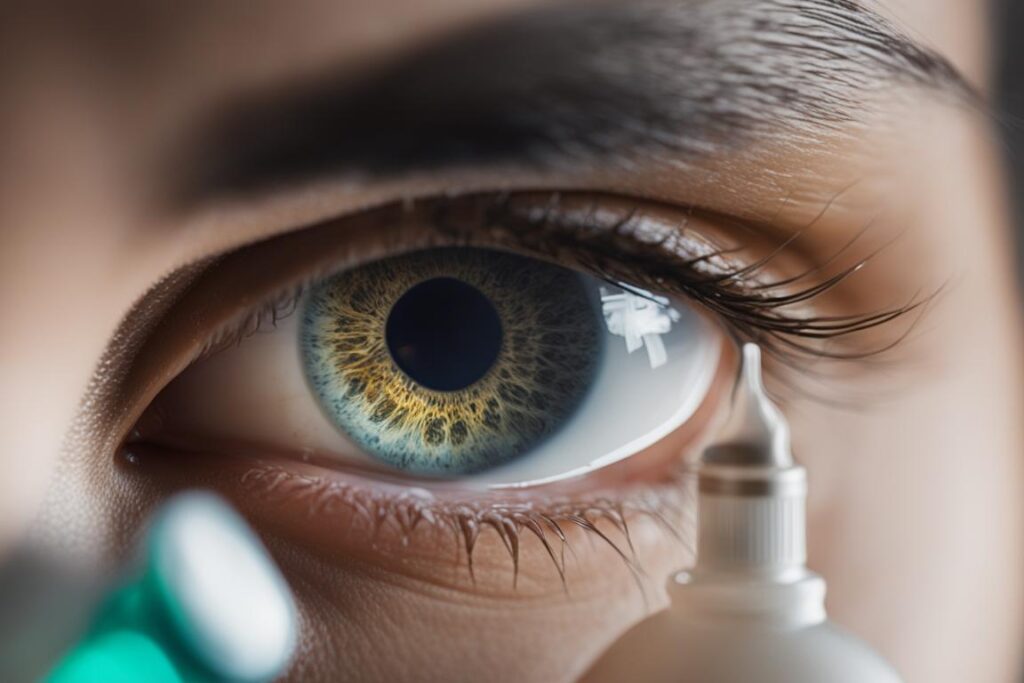Glaucoma is a serious eye condition that can lead to blindness. As a cannabinoid found in the cannabis plant, CBG shows promise in reducing intraocular pressure, a key factor in glaucoma. Researchers have conducted studies on CBG’s effects on glaucoma and have found that it may help lower intraocular pressure and potentially provide relief for glaucoma patients. While further research is needed to fully understand its effectiveness and safety, CBG offers potential benefits for eye health.
Key Takeaways:
- CBG, a cannabinoid found in cannabis, shows potential in treating glaucoma by reducing intraocular pressure.
- Researchers believe the endocannabinoid system, specifically CB1 and CB2 receptors, may play a role in regulating eye pressure.
- CBG is more concentrated in younger cannabis plants and does not produce a psychoactive “high” like THC.
- CBG can be administered topically or systemically, with eye drops containing CBGA showing promise in reducing eye pressure.
- CBG, along with other cannabinoids like CBD, offers alternative treatment options for glaucoma patients, but further research is needed.
The Endocannabinoid System and Glaucoma
The endocannabinoid system plays a crucial role in regulating various functions in the body, including those related to eye health. It consists of CB1 and CB2 receptors, which interact with cannabinoids found in the body and in cannabis. In the context of glaucoma, researchers have been studying the potential connection between the endocannabinoid system and the regulation of intraocular pressure, a key factor in the development and progression of the disease.
The CB1 receptors are primarily found in the central nervous system, including the retina and the optic nerve, while the CB2 receptors are predominantly present in immune cells. Studies have shown that these receptors are involved in the modulation of intraocular pressure, suggesting that cannabinoids like CBG could potentially be used to lower eye pressure in glaucoma patients. However, the exact mechanisms of how CBG or other cannabinoids interact with the endocannabinoid system in the context of glaucoma require further research.
“The endocannabinoid system has emerged as a potential target for glaucoma treatment due to its regulatory role in intraocular pressure.”
The Role of CB1 Receptors
Certain studies have indicated that the activation of CB1 receptors can help reduce intraocular pressure by enhancing fluid outflow from the eye. This suggests that stimulating CB1 receptors with cannabinoids like CBG may have a beneficial effect on glaucoma. However, it is important to note that the activation of CB1 receptors can also have other effects throughout the body, which may be a consideration when exploring its potential as a treatment for glaucoma.
The Influence of CB2 Receptors
While CB2 receptors are not as abundant in the eye as CB1 receptors, they are involved in immune responses and inflammation. Glaucoma is characterized by chronic inflammation and damage to the optic nerve, and researchers believe that targeting CB2 receptors may help reduce inflammation and provide neuroprotective effects. The potential use of CBG or other cannabinoids that interact with CB2 receptors in glaucoma treatment is an area of ongoing investigation.
| CB1 Receptors | CB2 Receptors |
|---|---|
| Found in the retina and optic nerve | Primarily present in immune cells |
| Involved in regulating intraocular pressure | Modulates immune responses and inflammation |
| Potential target for glaucoma treatment | May provide neuroprotective effects in glaucoma |
Understanding CBG and Its Effects
Cannabigerol (CBG) is a cannabinoid found in the cannabis plant. It is usually present in smaller quantities compared to other cannabinoids like THC and CBD. CBG is more concentrated in younger cannabis plants and breaks down over time to form other cannabinoids. CBG does not produce a psychoactive “high” like THC, but it may have its own unique effects on the body. CBG can interact with CB1 receptors in the brain and potentially inhibit the effects of THC. Research on the specific effects of CBG is ongoing, and its potential in treating glaucoma is still being explored.
CBG breakdown:
| Cannabinoid | CBG Percentage in Young Cannabis Plants | Breakdown Over Time |
|---|---|---|
| THC | Low | Converts to THC-A |
| CBD | Low | Converts to CBD-A |
| CBG | Higher | Breaks down into other cannabinoids |
While CBG’s specific effects are still being studied, researchers believe that it may have potential medical benefits. Some preliminary evidence suggests that CBG may have anti-inflammatory properties, which could be beneficial for treating conditions like glaucoma. Additionally, CBG has shown promise in reducing intraocular pressure, a key factor in glaucoma. By interacting with CB1 receptors in the brain, CBG may help regulate eye pressure and potentially provide relief to glaucoma patients.
Research on CBG and its effects is ongoing, but early findings suggest that it may have therapeutic potential for glaucoma treatment. As we continue to explore the benefits and limitations of CBG, it’s important to conduct further research and clinical trials to fully understand its potential as a treatment option for glaucoma patients.
CBG and THC
CBG and THC are both cannabinoids found in the cannabis plant, but they have different effects on the body. While THC is known for its psychoactive properties and can induce a “high,” CBG does not have the same psychoactive effects. In fact, CBG may actually counteract some of the psychoactive effects of THC. By interacting with CB1 receptors in the brain, CBG can potentially inhibit the effects of THC and modulate its psychoactive properties. This interaction between CBG and THC highlights the complex nature of cannabinoids and their potential therapeutic applications.
CBG and CBD
CBD is another cannabinoid found in the cannabis plant that has gained popularity for its potential medical benefits. Like CBG, CBD does not produce a psychoactive “high” like THC. However, CBD and CBG have different mechanisms of action in the body. While CBG interacts primarily with CB1 receptors, CBD interacts with a variety of receptors including CB1 and CB2 receptors, as well as other non-cannabinoid receptors. The unique properties and interactions of CBG and CBD make them both interesting areas of research for potential therapeutic applications.
CBG and Intraocular Pressure
One of the key factors in glaucoma is intraocular pressure, which refers to the pressure inside the eye. Studies have shown that CBG, a cannabinoid found in the cannabis plant, may have the potential to reduce intraocular pressure and provide relief for glaucoma patients. Researchers have explored different methods of administering CBG, including topically through eye drops.
Currently, researchers have developed eye drops containing a compound called cannabigerolic acid (CBGA), which is the acidic form of CBG. These eye drops have shown promise in reducing eye pressure and reaching the back of the eye to potentially repair damage caused by glaucoma. Additionally, studies have found that CBG can increase fluid outflow in the eye, which may help to lower intraocular pressure.
To further understand the effects of CBG on intraocular pressure and its potential in glaucoma treatment, ongoing research is being conducted. It is important to note that while CBG shows promise, it is still a relatively new area of study, and more research is needed to fully understand its effectiveness and safety. However, the potential therapeutic benefits of CBG in reducing intraocular pressure and improving ocular health make it an exciting area of exploration for glaucoma treatment.

CBD and CBG for Glaucoma Treatment
When it comes to treating glaucoma, cannabinoids like CBD and CBG have been gaining attention for their potential benefits. While THC has long been associated with glaucoma treatment, CBD and CBG offer alternative options that may have fewer psychoactive effects. CBD, in particular, has been recognized for its anti-inflammatory properties and potential to reduce eye pressure. Studies have shown that CBD can effectively lower intraocular pressure, making it a promising candidate for glaucoma treatment.
CBG, on the other hand, has shown significant potential in reducing ocular pressure. Unlike THC, CBG does not produce a psychoactive high, which may make it a more desirable option for patients. Research has found that CBG can effectively lower intraocular pressure, offering relief to glaucoma patients. The combination of CBD and CBG may provide even greater benefits, as they can work together to reduce eye pressure and potentially protect the optic nerve.
“CBD and CBG have shown promise in reducing eye pressure and may provide alternative treatment options for glaucoma.”
It is important to note that while CBD and CBG hold potential for glaucoma treatment, further research is needed to fully understand their effectiveness and safety. Additionally, the method of administration and dosage may vary for each individual. Consulting with a healthcare professional is crucial when considering CBD or CBG as part of a glaucoma treatment plan. With ongoing research and advancements in cannabinoid therapy, CBD and CBG may become more widely recognized in the future as a regular part of glaucoma treatment.
Comparison Table: CBD vs. CBG vs. THC for Glaucoma Treatment
| CBD | CBG | THC | |
|---|---|---|---|
| Psychoactive Effects | No | No | Yes |
| Intraocular Pressure Reduction | Yes | Yes | Yes |
| Anti-Inflammatory Properties | Yes | Yes | No |
| Neuroprotective Effects | Yes | Yes | Yes |
The comparison table above highlights key differences between CBD, CBG, and THC in terms of psychoactive effects, intraocular pressure reduction, anti-inflammatory properties, and neuroprotective effects. While all three cannabinoids have shown potential for glaucoma treatment, CBD and CBG offer non-psychoactive options with additional therapeutic benefits. THC, on the other hand, may provide relief but also comes with the potential for psychoactive effects.
Risks and Considerations of CBG for Glaucoma
When considering the use of cannabigerol (CBG) for the treatment of glaucoma, it is important to be aware of the potential risks and considerations. While CBG has shown promise in reducing intraocular pressure and providing relief for glaucoma patients, there are some factors to keep in mind.
Risks of using cannabis for glaucoma
One concern is the potential risks associated with using cannabis, including CBG, for glaucoma treatment. Smoking cannabis can pose a risk of lung damage, which may be especially problematic for individuals with pre-existing lung conditions. To mitigate this risk, many patients opt for alternative methods of consumption, such as edibles or oils, which do not involve inhalation.
CBG side effects
Like any medication, CBG may have its own set of side effects. However, there is limited research on the specific side effects of CBG, as most studies have focused on other cannabinoids like THC and CBD. It is important to consult with a healthcare professional before using CBG to understand any potential side effects and ensure it is safe for you.
Duration of effects of cannabis for glaucoma
Another consideration is the duration of the effects of cannabis for glaucoma. Typically, the effects of cannabis last for four to six hours. This means that continuous use may be required to maintain reduced eye pressure. It is important to work closely with your healthcare provider to develop a treatment plan that suits your individual needs.
| Considerations | Risks |
|---|---|
| Potential lung damage | Smoking cannabis |
| Side effects | CBG use |
| Duration of effects | Continuous cannabis use |
“It is important to weigh the potential benefits of CBG for glaucoma against the potential risks and consider individual factors such as overall health and preferences for consumption methods.”
Overall, the use of CBG for glaucoma treatment shows promise, but it is important to approach it with caution and seek guidance from healthcare professionals. The potential benefits should be weighed against the potential risks, and individual factors such as overall health and preferences for consumption methods should be taken into account.

The Future of CBG in Glaucoma Treatment
As I delve into the world of CBG and its potential benefits for glaucoma treatment, I can’t help but be optimistic about its future. The ongoing research and development in this field hold tremendous promise for the use of CBG as a regular part of glaucoma treatment.
A significant breakthrough in CBG research is the development of eye drops containing cannabigerolic acid (CBGA). These eye drops have shown great potential in reducing intraocular pressure, reaching the back of the eye, and potentially repairing damage caused by glaucoma. This brings us one step closer to a more effective and targeted treatment for this debilitating eye condition.
However, it is important to note that further research is still needed to fully understand the long-term effectiveness and safety of CBG in glaucoma treatment. As scientists continue to explore the potential of CBG, we can expect to see more innovative developments and discoveries in this field of research.
With each new finding, we come closer to a future where CBG becomes a regular part of recommended treatment for glaucoma. As more studies are conducted, we will gain a better understanding of how CBG interacts with the body, its optimal dosage, and potential side effects. This knowledge will help healthcare professionals make informed decisions and provide the best possible care for glaucoma patients.
FAQ
Is CBG a potential treatment for glaucoma?
Yes, CBG has shown promise in reducing intraocular pressure, which is a key factor in glaucoma.
What is the endocannabinoid system and how does it relate to glaucoma?
The endocannabinoid system is a complex system in the body that regulates various functions, including those related to the eyes. It is believed to play a role in regulating intraocular pressure, which is associated with glaucoma.
How does CBG interact with the body?
CBG interacts with CB1 receptors in the brain and may inhibit the effects of THC. It is still being researched to fully understand its effects and benefits.
Can CBG help reduce intraocular pressure in glaucoma patients?
Studies have shown that CBG may help to lower eye pressure in glaucoma patients. It can be administered topically or systemically, with eye drops containing CBGA showing promise in reducing eye pressure.
Are there other cannabinoids besides CBG that can be used for glaucoma treatment?
Yes, CBD, another cannabinoid, has gained popularity for its potential anti-inflammatory properties and ability to reduce eye pressure caused by glaucoma.
What are the risks and considerations of using CBG for glaucoma?
Some concerns include potential lung damage from smoking cannabis and the duration of the effects, which may require continuous use. It is important to consult with a healthcare professional before using CBG or any other cannabis products for glaucoma treatment.
What does the future look like for CBG in glaucoma treatment?
The development of eye drops containing CBGA is a significant breakthrough, and further research is needed to fully understand the long-term effectiveness and safety of CBG for glaucoma.
Source Links
- https://www.thealchempist.com/blogs/endocannabinoid-research/is-cbg-good-for-glaucoma
- https://arborswellness.com/blog/cannabis-treatment-of-glaucoma/
- https://www.ncbi.nlm.nih.gov/pmc/articles/PMC1772142/
Author Profile

Latest entries
 BlogFebruary 20, 2024I Just Found the Ultimate Clog-Free Vape Cartridge! (Yes, They Exist!)
BlogFebruary 20, 2024I Just Found the Ultimate Clog-Free Vape Cartridge! (Yes, They Exist!) BlogJanuary 16, 2024In the Clouds with Creativity: A Blunt Encounter with Montreal’s Fluid Art Maestro
BlogJanuary 16, 2024In the Clouds with Creativity: A Blunt Encounter with Montreal’s Fluid Art Maestro BlogDecember 25, 2023Sativa: Enhancing Outdoor Adventures
BlogDecember 25, 2023Sativa: Enhancing Outdoor Adventures BlogDecember 25, 2023Enhancing Memory with Sativa
BlogDecember 25, 2023Enhancing Memory with Sativa





